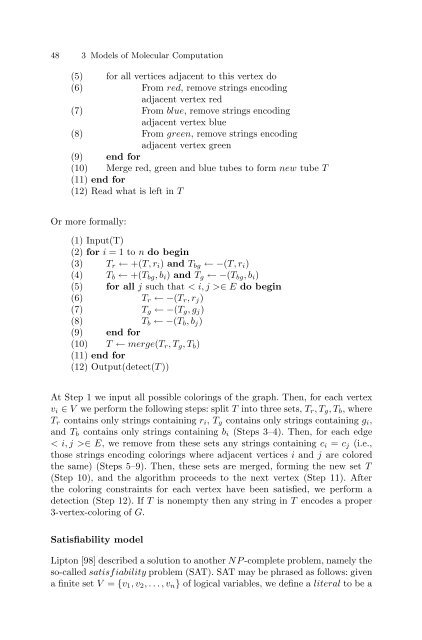Theoretical and Experimental DNA Computation (Natural ...
Theoretical and Experimental DNA Computation (Natural ...
Theoretical and Experimental DNA Computation (Natural ...
You also want an ePaper? Increase the reach of your titles
YUMPU automatically turns print PDFs into web optimized ePapers that Google loves.
48 3 Models of Molecular <strong>Computation</strong><br />
(5) for all vertices adjacent to this vertex do<br />
(6) From red, remove strings encoding<br />
adjacent vertex red<br />
(7) From blue, remove strings encoding<br />
adjacent vertex blue<br />
(8) From green, remove strings encoding<br />
adjacent vertex green<br />
(9) end for<br />
(10) Merge red, green <strong>and</strong> blue tubes to form new tube T<br />
(11) end for<br />
(12) Read what is left in T<br />
Or more formally:<br />
(1) Input(T)<br />
(2) for i =1ton do begin<br />
(3) Tr ← +(T,ri) <strong>and</strong> Tbg ←−(T,ri)<br />
(4) Tb ← +(Tbg,bi) <strong>and</strong> Tg ←−(Tbg,bi)<br />
(5) for all j such that ∈ E do begin<br />
(6) Tr ←−(Tr,rj)<br />
(7) Tg ←−(Tg,gj)<br />
(8) Tb ←−(Tb,bj)<br />
(9) end for<br />
(10) T ← merge(Tr,Tg,Tb)<br />
(11) end for<br />
(12) Output(detect(T ))<br />
At Step 1 we input all possible colorings of the graph. Then, for each vertex<br />
vi ∈ V we perform the following steps: split T into three sets, Tr,Tg,Tb, where<br />
Tr contains only strings containing ri, Tg contains only strings containing gi,<br />
<strong>and</strong> Tb contains only strings containing bi (Steps 3–4). Then, for each edge<br />
∈ E, we remove from these sets any strings containing ci = cj (i.e.,<br />
those strings encoding colorings where adjacent vertices i <strong>and</strong> j are colored<br />
the same) (Steps 5–9). Then, these sets are merged, forming the new set T<br />
(Step 10), <strong>and</strong> the algorithm proceeds to the next vertex (Step 11). After<br />
the coloring constraints for each vertex have been satisfied, we perform a<br />
detection (Step 12). If T is nonempty then any string in T encodes a proper<br />
3-vertex-coloring of G.<br />
Satisfiability model<br />
Lipton [98] described a solution to another NP-complete problem, namely the<br />
so-called satisfiability problem (SAT). SAT may be phrased as follows: given<br />
a finite set V = {v1,v2,...,vn} of logical variables, we define a literal to be a







